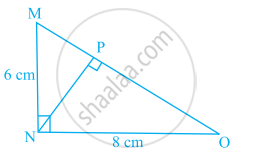Advertisements
Advertisements
Question
Prove that the points A (a,0), B( 0,b) and C (1,1) are collinear, if `( 1/a+1/b) =1`.
Solution
Consider the points A (a,0), B( 0,b) and C (1,1) .
` Here (x_1=a,y_1=0).(x_2 = 0,y_2=b) and (x_3=1,y_3=1).`
It is given that the points are collinear. So,
`x_1 (y_2-y_3)+x_2(y_3-y_1) +x_3(y_1-y_2) =0`
`⇒ a(b-1)+0(1-0)+1(0-b)=0`
`⇒ ab-a-b=0`
Dividing the equation by ab:
`⇒ 1-1/b-1/a=0`
`⇒ 1-(1/a+1/b)=0`
`⇒(1/a+1/b)=1`
Therefore, the given points are collinear if `(1/a+1/b)=1`
APPEARS IN
RELATED QUESTIONS
ABCD is a rectangle formed by the points A(-1, -1), B(-1, 4), C(5, 4) and D(5, -1). P, Q, R and S are the midpoints of AB, BC, CD and DA respectively. Is the quadrilateral PQRS a square? a rectangle? or a rhombus? Justify your answer.
Find values of k if area of triangle is 4 square units and vertices are (−2, 0), (0, 4), (0, k)
Prove that the points (2,3), (-4, -6) and (1, 3/2) do not form a triangle.
If G be the centroid of a triangle ABC and P be any other point in the plane, prove that PA2+ PB2 + PC2 = GA2 + GB2 + GC2 + 3GP2.
prove that the points A (7, 10), B(-2, 5) and C(3, -4) are the vertices of an isosceles right triangle.
Find the value of y for which the points A(-3, 9), B(2,y) and C(4,-5) are collinear.
If the points (a1, b1), (a2, b2) and(a1 + a2, b1 + b2) are collinear, then ____________.
If the points (2, -3), (k, -1), and (0, 4) are collinear, then find the value of 4k.
A(6, 1), B(8, 2) and C(9, 4) are three vertices of a parallelogram ABCD. If E is the midpoint of DC, find the area of ∆ADE.
In the given figure, ΔMNO is a right-angled triangle. Its legs are 6 cm and 8 cm long. Length of perpendicular NP on the side MO is ______.

